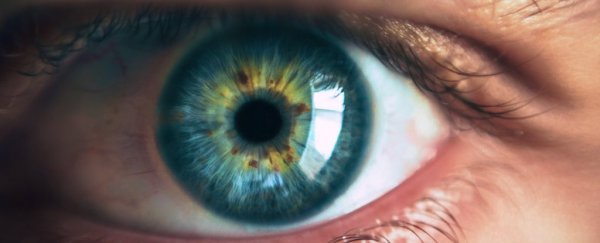The dangers of staring directly into laser pointers are well documented, but an unfortunate incident involving a teenager from Ohio serves as a sobering reminder of just how little it takes to cause permanent damage to your eyes and vision.
In a recent medical report, physicians document the case of the anonymous teen, who stared directly into a laser pointer for several seconds while playing a 'shooting game' with his friends.
The device used was a laser pointer toy intended for exercising pets. While devices like this are often advertised as being low-power lasers, that's now always the case, and mounting evidence of retinal damage caused by such pointers suggests the risk is growing, researchers say, even though people might not be aware of it.
"Increasing availability, higher output powers, and development of devices emitting in the blue and green wavelengths are thought to be attributable," the team, led by first author and medical student Carol Vitellas from Ohio State University (OSU) explains in the report.
"Though commonly believed to be safe, even brief laser-pointer exposure to the eye can lead to permanent vision loss, with children being particularly at risk."
Sadly, that's exactly what happened to the teen in this case. Despite only looking at the laser directly for a matter of seconds, immediately afterwards he experienced a form of vision loss for several minutes, after describing the initial visual effect as a bright light.
Five months after the incident, the boy, experiencing ongoing blurred vision and partial vision loss in his right eye, went to see OSU ophthalmologist Frederick Davidorf.
At the time, the boy said he sometimes couldn't see individual letters when reading text with his right eye (with his left eye closed). At that point, tests revealed visual acuity was slightly diminished in his right eye, but presented as normal in his left eye.
On a subsequent visit six months later, his visual acuity was found to have improved to a normal level in both eyes, but that seemingly positive result didn't reflect the harm done inside the eye.
 Two large lesions and smaller areas of cone loss in the right eye. (Wolters Kluwer Health, Inc)
Two large lesions and smaller areas of cone loss in the right eye. (Wolters Kluwer Health, Inc)
Using a high-resolution optical scanning system, Davidorf saw first-hand the damage done to the boy's retinas, where entire regions of light-sensitive photoreceptors cells (aka rods and cones) had been "blasted away" by the laser, as Davidorf puts it.
"There's just nothing left there," Davidorf says. "The affected areas are devoid of cones."
The boy was diagnosed with macular laser burns in both eyes, given no other confounding conditions could explain the vision loss he was experiencing.
Using the high-power optical system – called an Adaptive Optics-OCT-Scanning Laser Ophthalmoscope (AO-OCT-SLO) – researchers can actually count individual cells making up this part of the retina.
Unfortunately for their patient, lesions caused by the laser had seemingly eradicated photoreceptor cells in the boy's retinas, with two lesions in his right eye and one in the left.
The good news is that, with time, it appears the boy's injury might be slowly getting better, although a full recovery is not on the cards, the team thinks.
The teen had his eyes scanned with the ophthalmoscope on two occasions, at 11 and then 20 months after the injury was sustained. During the interim, the researchers observed a slight decrease in the size of the lesions.
"It's never going to fully heal," Davidorf says. "There will always be scarring there."
With sufficient time, hopefully the boy recovers more of his vision, but in the meantime, his experience serves as a valuable caution of the dangers that these tiny devices and toys pose to people's eyes.
That's especially so since it's difficult or impossible to know exactly how powerful a particular laser might be, and while some previous research might suggest the risks are overblown, unfortunate cases such as this one speak directly to the contrary.
"Handheld lasers can range in power from <5 mW (typical laser pointers) to >1,200 mW (high power blue lasers capable of lighting cigarettes or remotely igniting fireworks)," the authors explain.
"Misuse can result in retinal injuries that can be localised to just the outer retina or may result in full thickness macular holes."
The findings are reported in Retinal Cases & Brief Reports.
